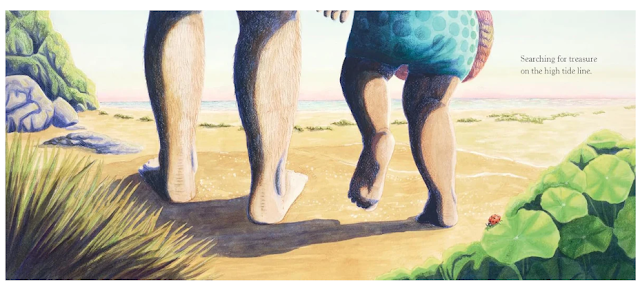I have read hundreds or even thousands of books, especially picture books, but every now and then a new book comes along that surprises and completely delights me. The first double spread took my breath away.
Think about all the conversations you could have over this one page - where are they going? who can you see? how do they feel? how do you know this? what do you know about the weather and the season? can you see some things on the edge of the sand near the water? what might they find?
When you walk along a beach you do have to look closely to see all the treasures. This book shows you the treasures in real life sizes, but you are invited to look really closely to discover an interesting science fact about each of these wondrous things. I am so excited to see fingernail shells - I well remember finding these on a beach when I was a very young child.
So, this could just be a science book about the seashore - but it is so much more. I am not going to spoil the final fold out page but it is sure to delight your young reader and perhaps entice you to take a walk along a nearby beach.
Bookseller blurb: Searching for treasure on the high tide line. One step, two steps, what can you find? A walk on the beach becomes a joyous, creative adventure. What has the sea washed up? Can you find its hidden treasures? Find sea urchins and shark's eggs, ghost crabs and cuttlefish, limpets and barnacles and so much more.
There is an important note on the imprint page - "With thanks to Dr Catherine Cavallo for her marine species expertise." So, you can be assured of the authority of the science facts.
You can share this book with a very young child because the text contains a repeated pattern but an older child is sure to be fascinated by all the tiny details written in tiny italic text beside each treasure.
One step, two steps, what can you find? Searching for treasure on the high tide line. Three steps, four steps, what can you find?
Here are a few 'fun facts':
- The best time to look for shells is after a storm
- Baby sharks are called pups!
- Sponges are animals not plants
- Periwinkles can't swim
Huge congratulations to Allen and Unwin on the book design used for Searching for Treasure. This book has a fold out which I already mentioned but there are also sculptured half pages somewhat like a lift-the-flap. The tide is out on the front end paper and the tide is coming back in on the back end paper. This has huge implications for the final image - oh no!
It is a long way off, but I am going to predict Searching for Treasure will be a CBCA 2026 Notable. Here are some teachers notes.
I loved that Searching for Treasure has two ways it can be read; large simple text is a prompt to look at the picture and point things out, plus there is small text between the treasures, educational facts winding between the illustrations. These were like hidden treasures in themselves. Little Squirrel's Bookshelf (click this link to see more illustrations inside this book)
The final gatefold is masterful! The Bottom Shelf
Johanna Bell lives in Tasmania where she writes fiction and runs a community arts business called StoryProjects. Johanna is the author of The Colour Catchers, illustrated by Laura Stitzel and Hope is the Thing, illustrated by Erica Wagner.
Emma Long is an accomplished artist, exhibiting regularly in group and solo exhibitions across the Northern Territory. Emma lives in Darwin with their husband and four children and continues to work as an illustrator and an art educator. Other books they have illustrated include Diane Lucas and Ben Tyler's Walking in Gagudju Country and Walking the Rock Country in Kakadu.





No comments:
Post a Comment